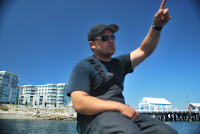Our guide for the day was Michael Child
 of SeaQuest Adventures, recommended by the folks at Raincoast. SeaQuest is a small company operating right next to Sidney’s harbor. A group of 15 of us hopped into their zodiac and sped off towards San Juan Island (WA), where a pod had been spotted. Though it was afternoon on a bright sunny day, we soon entered a fog bank that seemed out of an episode of Scooby Doo. Michael cut the engine in a spot where the orcas were to be passing soon, our zodiac bobbing on the choppy water in the soupy mist.
of SeaQuest Adventures, recommended by the folks at Raincoast. SeaQuest is a small company operating right next to Sidney’s harbor. A group of 15 of us hopped into their zodiac and sped off towards San Juan Island (WA), where a pod had been spotted. Though it was afternoon on a bright sunny day, we soon entered a fog bank that seemed out of an episode of Scooby Doo. Michael cut the engine in a spot where the orcas were to be passing soon, our zodiac bobbing on the choppy water in the soupy mist.
Soon we were rewarded with the first group of orcas passing by. The fog made clear views and photographs challenging but as we stayed moved with the pod, the fog burned off revealing both San Juan Island just to our east and the beautiful black and white markings of the orcas. We had come across “J Pod”, a group of fish eating orcas that spend all year in this area. The animals treated us to a couple of spy hops and breaches but mostly just kept moving. As the initial whales moved away, Michael got word more were on the way. After a while, it became apparent that we had come across a “super pod” where several pods were traveling together, a relatively rare ritual.
Michael cut the engine and we floated as at least
 20 orcas came by in groups of two and three. His passion and respect for these animals was clear as he shared their natural history, threats, and research. These animals face two main challenges from people, toxins and the loss of food. These orcas live primarily off of salmon, whose numbers have dropped dramatically over the past century as dams and fishing have proliferated. Much of the toxins from the major cities in the region accumulate in these waters and move their way up the food chain in a process called “bioaccumulation” where the top predators like orcas end up with large amounts of PCB’s and other nasty chemicals that make breeding more difficult.
20 orcas came by in groups of two and three. His passion and respect for these animals was clear as he shared their natural history, threats, and research. These animals face two main challenges from people, toxins and the loss of food. These orcas live primarily off of salmon, whose numbers have dropped dramatically over the past century as dams and fishing have proliferated. Much of the toxins from the major cities in the region accumulate in these waters and move their way up the food chain in a process called “bioaccumulation” where the top predators like orcas end up with large amounts of PCB’s and other nasty chemicals that make breeding more difficult.
Due to new whale watching regulations, we had to keep at least 200 meters from the killer whales, which Michael was careful to respect. While there may be dozens of boats in the water at a time watching the whales, at least the commercial boats we saw that day were generally respectful and not approaching too close or blocking their path. The one boat we saw not following regulation was a private boat that was speeding towards the pod, only stopping only a short distance in front of the group.
The new regulations are a local controversy with whale watching operations claiming that their activities have minimal impact on the whales while some local groups claim they are a major threat to the survival of the orcas. The SoundWatch Boater Education Program is an effort by the Whale Museum to minimize these impacts by monitoring and educating both commercial boats as well as private ones. Their Be Whale Wise voluntary guidelines have been adopted by the majority of both Canadian and US commercial boats. In 2010, of the more than 1,000 incidents recorded, more than 60% were private boats and fewer than 15% were commercial whale watch operators. Regardless, we hope all whale watching boats take every possible measure to reduce the noise and pollution of their engines and manage their boats to reduce impacts on the whales.
Whale watching in this region is part of its life blood;
 orcas adorn flags, walls, shirts, and just about everything else you can put a picture on. According to SoundWatch, more than 500,000 people go whale watching in this region every year. More than 500 people directly survive from taking people out and thousands more indirectly benefit from the visitors. If anything were to happen to wipe these animals out, it would impact many communities. Hopefully this powerful constituency will actively support efforts to keep the orcas safe from looming threats like a proposal to allow huge oil tankers to start coming through the area.
orcas adorn flags, walls, shirts, and just about everything else you can put a picture on. According to SoundWatch, more than 500,000 people go whale watching in this region every year. More than 500 people directly survive from taking people out and thousands more indirectly benefit from the visitors. If anything were to happen to wipe these animals out, it would impact many communities. Hopefully this powerful constituency will actively support efforts to keep the orcas safe from looming threats like a proposal to allow huge oil tankers to start coming through the area.
Learn more:
-Orca Facts & Conservation Tours


